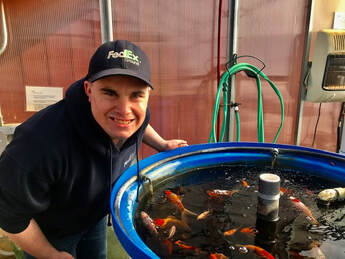
Aquaponics is actually the combination of two different farming methods, aquaculture (raising fish in a man-made system) and hydroponics (growing crops in a man-made aquatic system without soil). Aquaponics uses both fish and plants together in the same system. The fish and plants help each other—the waste from the fish helps to fertilize the plants, and the plants clean the water for the fish. Aquaponics is a closed-loop system, so the water in the system can continue to be reused after it cycles through the entire system. It mimics a natural ecosystem by taking advantage of the relationship between fish, plants, and bacteria to create a self-sustaining environment for all three of them, in a way that aquaculture and hydroponics individually do not.
After we feed the fish, the fish eat their food and excrete waste. Most of this waste is in the form of ammonia. Bacteria in the water convert the ammonia first to nitrites and then to nitrates, which the plants use as food. The fish, the plants, and the beneficial bacteria all depend on each other. The bacteria depend on the fish for nitrogen, the plants depend on the bacteria to convert the nitrogen to a form the plants can use, and the fish depend on the plants to absorb the nitrogen and clean the water. We do need to check the chemistry of our water frequently, including pH and nitrogen levels, because that indicates the health of the system and our fish.
Aquaponics is a very efficient method of growing crops, since it uses a minimum amount of water and space and reuses waste. Aquaponics provides food in the form of vegetables and herbs, and fish can also be raised sustainably in aquaponics. For us at GBG, we presently grow non-edible fish such as koi, which are able to tolerate a wide range of temperatures and are especially well-suited for aquaponics operations in colder climates.
Some of aquaponics’ main benefits include the fact it reduces back strain on people, limits small animals’ access to your garden, and only uses one-tenth of the water that soil-based gardening uses—and even less than that for hydroponics. It also doesn’t create toxic runoff from wastewater the way hydroponics and aquaculture do. Also, gardening chores are greatly reduced; you mainly need to focus on tending to and harvesting the plants as well as feeding the fish. Also, a couple other benefits are that growing plants in water eliminates the possibility of soil-borne diseases, and that the plants are free of pesticides and herbicides and the fish are also free of growth hormones and antibiotics.
Although aquaculture and hydroponics have only started gaining traction within the last half century, these growing methods have both been around for hundreds, maybe thousands, of years. The earliest known instance of hydroponics dates back to 1000 AD, when the Aztecs grew plants on rafts on the surface of lakes. As for aquaculture, in ancient times many farmers grew rice in rice paddy fields, and introduced fish to the water. This second example is similar to modern aquaponic farming, in how the fish and plants both live together in a body of water and form a symbiotic relationship with each other.
Various kinds of vegetables and herbs can grow well in aquaponics, such as herbs and greens including lettuce, basil, Swiss chard, kale, sorrel, and many others. Among the best kinds of fish to use in aquaponics are tilapia, catfish, trout, bass, goldfish, and koi. A general rule of thumb is that warm, fresh-water fish are the best kind of fish to use, and leafy crops like greens, herbs, etc. are the best kinds of plants to grow.
If you’re wondering if aquaponics is commercially feasible, a study from Purdue University discovered that commercial-scale aquaponics is indeed feasible, but only if aquaponics produce is sold as organic produce beginning in the third year of aquaponics business. Also, I would like to add that vegetable growing is the main source of revenue for aquaponics systems, and that the use of tilapia in aquaponics is currently not profitable. The kind of fish we use in our system is koi, which we chose to avoid problems with using tilapia or other similar fish, and to avoid needing to filet the fish ourselves.
My favorite part about aquaponics is that it doesn’t require as much watering as conventional farming. Also, the plants don’t need to be fertilized, since the fertilizer comes from the fishes’ waste. Also, the crops grow faster in aquaponics than in the soil and we enjoy the process of seeding, transplanting, tending to our plants, and harvesting them for the community. It’s been a great way to grow and we look forward to continuing to grow on and up with aquaponics!
-Chris Tidmarsh
 RSS Feed
RSS Feed
